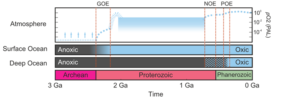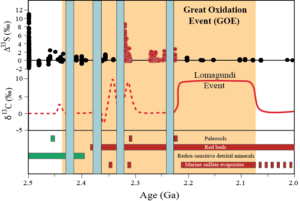Earth’s Great Oxidation: Redox and nutrient controls on the transition to a permanently oxygenated atmosphere
Earth’s Great Oxidation: Redox and nutrient controls on the transition to a permanently oxygenated atmosphere
Professor Simon Poulton (SEE), Dr Benjamin Mills (SEE), Dr Andrey Bekker (University of California, Riverside)
Contact email: s.poulton@leeds.ac.uk
The rise of oxygen on the early Earth has been recognised as one of the most significant episodes in the history of our planet, and this initial rise set in motion a prolonged chain of events that ultimately resulted in the habitable conditions we now enjoy. In recent years, the topic of early Earth oxygenation has received a huge amount of attention, and almost without exception, traditional views on the timing, causes and consequences of oxygenation have been shown to be incorrect (e.g., Krause et al., 2018; Alcott et al., 2019). The first stages of significant planetary oxygenation are believed to have started sometime after the evolution of oxygenic photosynthesis, and the environmental consequences of this are seen early in the geological record, perhaps (but controversially) as far back as 3.0 billion years ago (Crowe et al., 2013). However, a significant rise in atmospheric oxygen, from essentially nothing to a few percent of modern levels, occurred much later (Fig. 1). This rise has been dubbed the Great Oxidation Event (GOE; Holland, 2002), and for many years was considered to be just that – a single event. However, it is now apparent that early Earth oxygenation was much more complex than this, with the GOE occurring over a protracted period of time, with major rises and falls in oxygen levels (e.g., Gumsley et al., 2017; Poulton et al., 2021).

Figure 1: Redox history of Earth. Crosshatching indicates variable deep-ocean redox between the start of the Neoproterozoic Oxygenation Event (NOE) and the Paleozoic Oxygenation Event (POE). PAL: Present Atmospheric Level. From Alcott et al., 2019.
Indeed, recently it has been demonstrated that permanent oxygenation of the atmosphere during the GOE occurred 100 million years later than previously recognised, with major fluctuations in oxygen levels occurring over a 200 million year period (Fig. 2; Poulton et al., 2021). These fluctuations in atmospheric oxygen were linked to some of the most extreme perturbations in climate ever to affect the Earth, resulting in the first major glaciations of possible global extent – the so-called ‘Snowball’ Earth (Fig. 2). Following these glaciations, it is now apparent that the permanent rise of atmospheric oxygen was delayed until the Lomagundi C isotope excursion (Poulton et al., 2021), which represents the largest positive C isotope excursion in Earth history (Fig. 2). However, controls on the Lomagundi excursion, including its role in planetary oxygenation, are essentially unknown.

Figure 2: Dynamics of the Great Oxidation Event. Blue bars represent glaciations, some of which are considered global Snowball Earth events. D33S tracks the presence of oxygen in the atmosphere, whereby when D33S = 0 ± 0.03‰, oxygen concentrations were likely >10-5 PAL. Values outside this range indicate an anoxic atmosphere. Red circles indicate newly published data (Poulton et al., 2021). The carbonate C isotope profile (d13C) shows major fluctuations, with more positive values likely indicating nutrient/productivity-driven pulses of organic carbon burial and associated oxygen release to the atmosphere. Bottom section highlights key lines of geological evidence for reducing (green) and oxidising (red) Earth surface conditions. From Poulton et al. (2021).
One key parameter that impacts greatly on the course of oxygenation is the availability of key nutrients, through their impact on primary productivity, carbon burial and oxygen release. The bioavailability of nutrients depends, to a large extent, on the supply of nutrients to the ocean through weathering and the subsequent behaviour of nutrients during deposition and diagenesis under different redox states. In this context, the precise redox state of the ocean has a huge impact on whether nutrients such as P and bioessential trace metals are fixed in the sediment or recycled back to the water column, where they can stimulate further productivity (e.g., März et al., 2008). Thus, a detailed understanding of nutrient availability during key intervals of planetary oxygenation also requires that geochemical studies are placed firmly in the context of ocean redox reconstructions. However, our understanding of ocean redox conditions, as well as P and trace metal micronutrient cycling and bioavailability after the final glaciation of the GOE and through the Lomagundi excursion, are almost non-existent. This hugely limits our ability to decipher links between the Lomagundi excursion and the most significant change in atmospheric chemistry in Earth’s history.
Aims and Objectives
This project will take a new approach to unravelling nutrient availability by examining the speciation of phosphorus and trace metals in marine shales deposited across the final ~150 million years of the GOE (i.e., across the Lomagundi excursion). All of the nutrient analyses will be set in the context of the precise redox conditions encountered in the overlying water column and during diagenesis, while multiple sulphur isotope analyses will be applied in order to better constrain the precise timing of permanent atmospheric oxygenation. These data will be combined with state-of-the-art biogeochemical modelling to test oxygenation hypotheses and to upscale local geochemical data to the global scale. There will be several key aims, including:
- How did Earth surface oxygen levels vary across the final glaciation of the GOE and in its immediate aftermath? Did the transition to a permanently oxygenated atmosphere occur at this time, or slightly later during the onset of the Lomagundi excursion?
- 2. What was the nature of ocean redox chemistry at the height of the Lomagundi excursion and how did this evolve during its termination? Is there evidence for enhanced nutrient bioavailability driven by changes in weathering and/or redox conditions?
- Did changes in nutrient bioavailability cause the Lomagundi excursion, and what controlled its termination? How high did oxygen levels rise at this time and were these levels maintained after the Lomagundi excursion?
In answering these questions, this project will address several major outstanding issues related to the early evolution of Earth’s surficial environment and the ultimate development of a planet habitable for oxygen-breathing organisms.
Methodology
A superb suite of unweathered rocks, which have only been subjected to low-grade metamorphism, are already available from the in-house collections of the supervisors, including critical sections from South Africa, Botswana, Brazil and North America. The availability of these samples will ensure a successful start to the project, even if travel is limited by the Covid pandemic. However, it is expected that these sample sets will be added to as the project progresses, via fieldwork conducted by the student and supervisory team. A range of techniques will be applied to the rocks, including C-S-Fe systematics, P speciation and trace metal techniques. The supervisory group are amongst the first researchers to apply P speciation techniques to ancient rocks and have been instrumental in refining these techniques to make them more suited to ancient systems. It is also anticipated that advanced isotopic techniques will be applied to certain samples to evaluate atmospheric oxygenation dynamics and potential weathering controls on nutrient fluxes to the ocean. Finally, the student will apply cutting-edge biogeochemical modelling tools to enhance global-scale understanding of oxygenation dynamics.
Training
With this project you will work with leading biogeochemists and biogeochemical modellers at Leeds and at the University of California, Riverside. The supervisory team has worked at the forefront of reconstructing redox and nutrient cycling in modern and ancient environments for some years, with extensive experience working on early Earth oxygenation and its consequences. You will receive training in a wide variety of state-of-the-art geochemical and isotopic techniques, as well as biogeochemical modelling, which includes techniques that the project supervisors have been personally responsible for developing. In addition, you will be trained in a wide variety of key transferable skills within the Faculty Graduate School.
Opportunity for Travel
It is anticipated that further sampling will be required as the project progresses and key intervals are identified, and the student will undertake such sampling with the supervisors. The student will also be encouraged to present their research at national and international conferences (for example, the International V.M. Goldschmidt Conference, which will be held in France in 2023 and USA in 2024).
Potential for high impact outcome
The topic of early Earth oxygenation has been a major research agenda over the last few years, with multiple publications in the highest ranked journals such as Nature and Science. This project will apply geochemical and biogeochemical modelling techniques that have never before been applied to this time period, and as a consequence the results will be highly novel. It is therefore expected that this project will result in several publications in world-leading disciplinary and interdisciplinary journals.
References
- Alcott, L.J., Mills, B.J.W., Poulton, S.W., 2019, Stepwise Earth oxygenation is an inherent property of global biogeochemical cycling. Science 366: 1333–1337.
- Crowe, S.A. et al., 2013, Atmospheric oxygenation three billion years ago. Nature 501: 535-538.
- Gumsley, A.P. et al., 2017, Timing and tempo of the Great Oxidation Event. Proc. Natl Acad. Sci. USA 114: 1811–1816.
- Holland, H.D., 2002, Volcanic gases, black smokers, and the Great Oxidation Event. Geochim. Cosmochim. Acta 66: 3811–262.
- Krause, A. J., Mills, B.J.W, Zhang, S., Planavsky, N.J., Lenton, T.M., Poulton, S.W., 2018, Stepwise oxygenation of the Paleozoic atmosphere. Nature Communications 9:4081.
- März, C., Poulton, S.W., et al., 2008, Redox sensitivity of P cycling during marine black shale formation: Dynamics of sulfidic and anoxic, non-sulfidic bottom waters. Geochim. Cosmochim. Acta 72: 3703-3717.
- Poulton, S.W., Bekker, A. et al., 2021, A 200-million-year delay in permanent atmospheric oxygenation. Nature 592: 232-236.
